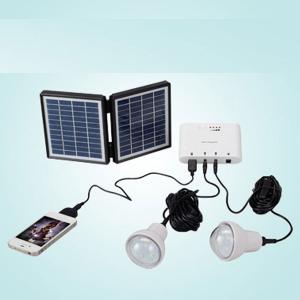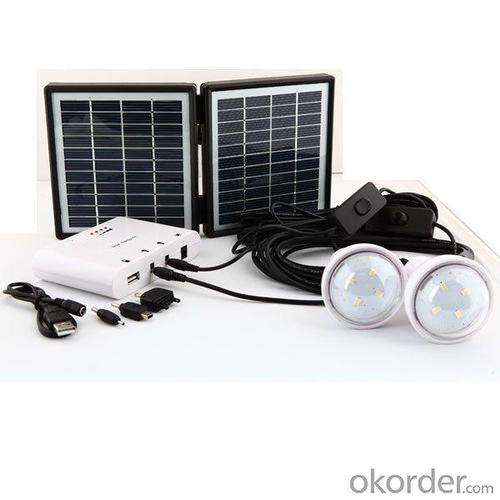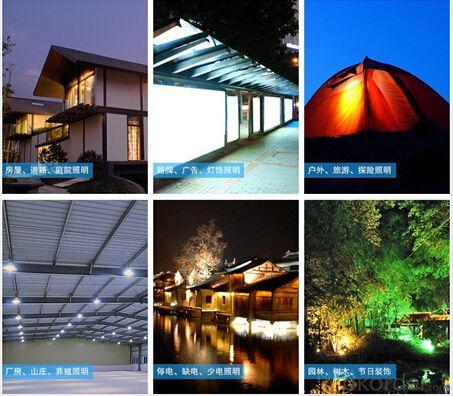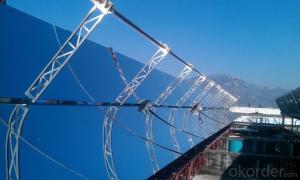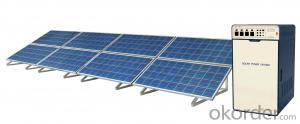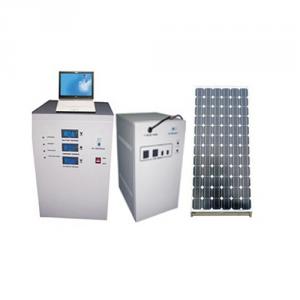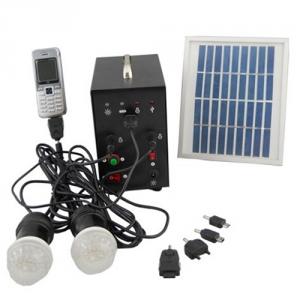Solar Energy Systems Melbourne FL:3.4w Solar Lighting System with Mobile Charge, 3.4w Solar Panel, 2600mAh Battery, 2 LED Globe Bulbs
- Loading Port:
- Shenzhen
- Payment Terms:
- TT/LC
- Min Order Qty:
- 100Sets set
- Supply Capability:
- 20000 SETS Per Month set/month
OKorder Service Pledge
OKorder Financial Service
You Might Also Like
This 3.4w solar lighting system with mobile charge 3.4w solar panel 2600mAH 7.4V and 2 led globe bulbs. This portable solar energy system can generate power for 2 LED bulbs, it can work 10 to 20 hours every day.
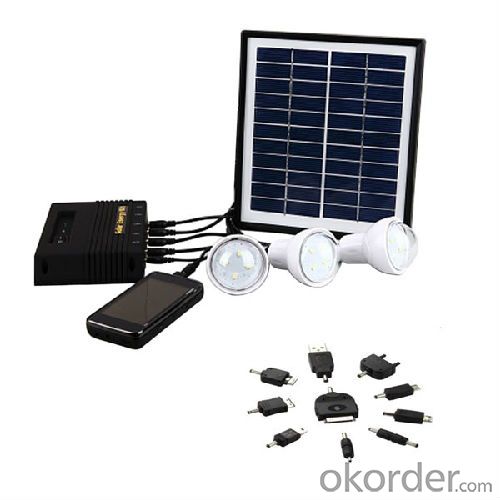
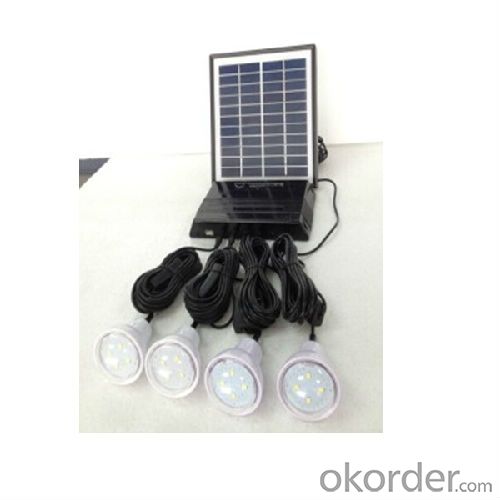

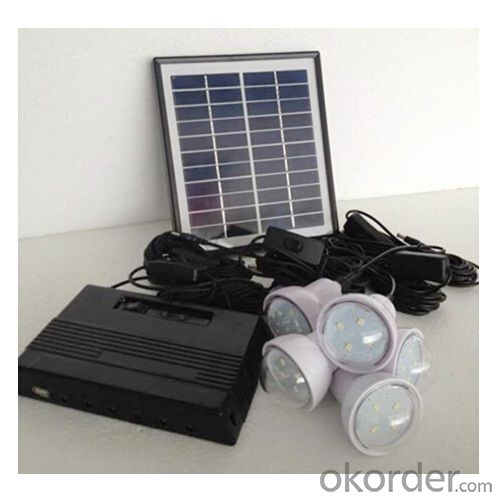
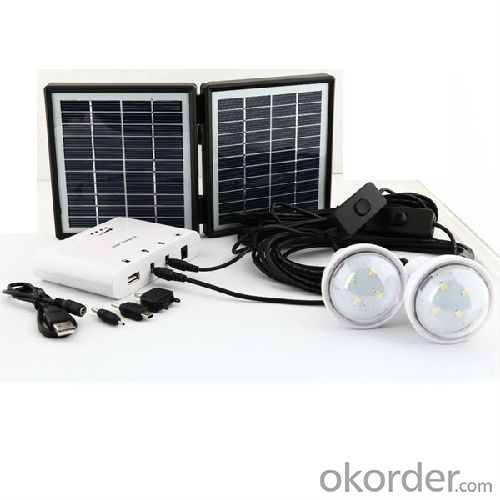
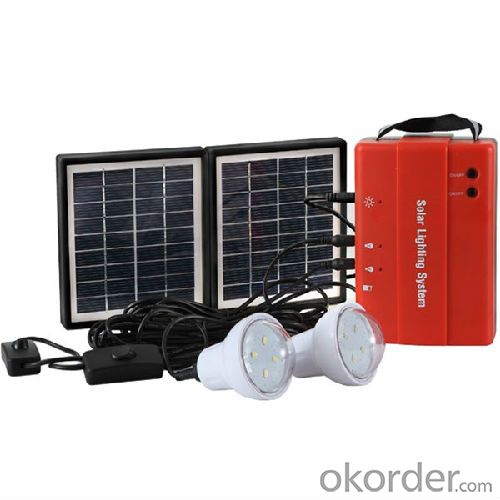
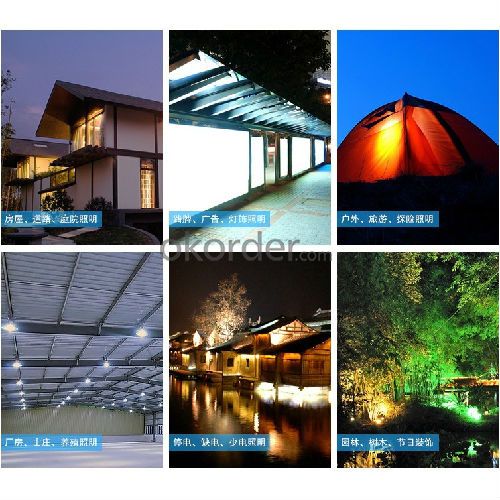
Parameter
1, Rechargeable by solar or AC adaptor;
2 With Mobile phone charging function (3 standard charging connectors for Nokia6101,Sony EricssonK750 and Mini USB)
3. Housing material: ABS;
4. Battery: 2.6AH/3.7V*2pcs Li-ion ;
5. Lighting time: 20 hours after fully charged; 10hrs after one day charge by sun.
6. Accessory: two bulbs with 5M long cable(with switch on the cable)
7.Over charge and over discharge protection.
Feature
Mini Solar Lighting System With 2 Lights (Lithium Battery)
1, Foldable solar panels
2, 4 LED indicators
3, USB mobile charging
4, CE,Design Patent
Usage/Applications
Rural homes, campers, fishermen, outdoor campaigns or activities, etc. Remote area, mountainous area, desert area, grassland area,
Village, country area, Camping, outdoor activities, travel, Lighting at night.
Customized options
1. OEM/ODM available;
2. It's also available to customize your own solar lighting systems, solar lanterns, or any solar lighitng products by giving us solar lights picture / 3D draft / technical datas.
Packing & Delivery
Package:
1* solar panel
1* portable system box
2* LED bulbs with on/off button on cable
inner box size: 335*255*84mm
10pcs/carton
carton size: 525*350*450mm
Delivery:
|
Shipping Service |
Estimated Delivery Time |
|
DHL |
2-8 business days |
|
FedEx |
3-8 business days |
|
TNT |
2-10 business days |
|
UPS |
1-7 business days |
|
EMS |
6-14 business days |
|
ePacket |
7-12 business days |
|
China Post Air Mail |
7-15 business days |
|
China Post SAL |
14-30 business days |
|
Air freight |
3-10 business days |
|
By Sea |
30-40 business days |
1. 3-5 business days for Sample Orders; 7-30 business days for Bulk Orders for Bulk Orders.
2. "Business days" means Monday-Friday, excluding holidays.
3. DHL and UPS cannot ship to military or P.O. boxes address
4. The Shipping Service above is for reference only, for any other questions, please feel free to contact us.
Factory
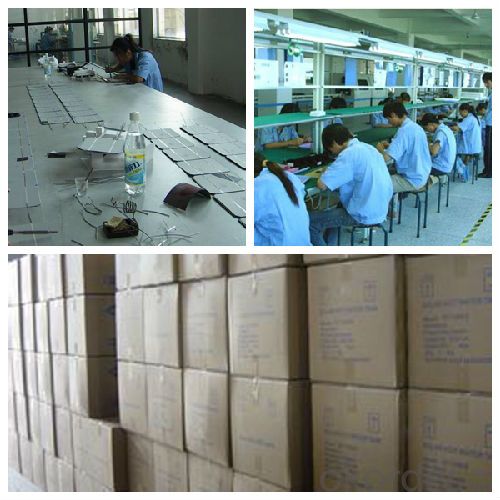
- Q: Can solar energy systems be used in areas with limited access to solar fuses and breakers?
- Yes, solar energy systems can still be used in areas with limited access to solar fuses and breakers. While fuses and breakers are important components for safety and protection in a solar energy system, there are alternative methods available to ensure the system operates safely. These can include using surge protectors, isolators, and other protective devices to prevent overloads and short circuits. Additionally, proper installation, regular maintenance, and adherence to safety guidelines can help mitigate risks even in areas with limited access to solar fuses and breakers.
- Q: Can solar energy systems be used for commercial purposes?
- Yes, solar energy systems can definitely be used for commercial purposes. In fact, many businesses across various industries are increasingly adopting solar power systems to reduce their reliance on traditional energy sources and lower their carbon footprint. Solar energy can be harnessed through photovoltaic (PV) panels or solar thermal systems, providing a clean and renewable source of electricity or heat for commercial buildings, manufacturing facilities, retail stores, and other commercial spaces. Moreover, installing solar energy systems can also lead to long-term cost savings and contribute to building a sustainable and environmentally friendly brand image.
- Q: Are there any limitations to installing a solar energy system in a homeowner's association?
- Yes, there can be limitations to installing a solar energy system in a homeowner's association (HOA). While many HOAs have embraced renewable energy and have adopted guidelines to facilitate solar installations, some may have restrictions or limitations in place. One limitation is that the HOA may have specific aesthetic guidelines or architectural standards that must be adhered to. This means that the solar panels may need to be installed in a way that aligns with the overall design and appearance of the community. In some cases, this could mean limitations on the size, location, or visibility of the panels. Another limitation is the potential impact on property values. While solar energy systems are generally seen as a desirable feature, there could be concerns among some homeowners about the impact on property values. In some cases, the HOA may require an approval process, including a review by a committee or board, before allowing installation. Additionally, there may be limitations related to the structural integrity of the property. Solar panels can be heavy, and certain roofs or structures may not be able to accommodate the added weight. The HOA may require a structural assessment or engineering report to ensure that the installation will not compromise the integrity of the building. Lastly, there may be limitations related to legal and regulatory requirements. Depending on the jurisdiction, there may be specific permits, licenses, or agreements required for solar installations. The HOA may need to ensure that all necessary documentation and approvals are obtained, which can add time and complexity to the installation process. Overall, while many HOAs are supportive of solar energy systems, it is important for homeowners to review their specific HOA guidelines and engage in open communication with the association to understand any limitations or requirements that may be in place.
- Q: How do solar energy systems affect the insurance premiums of a property?
- Solar energy systems can potentially affect insurance premiums of a property in a positive way. Installing solar panels can increase the value of a property, which may result in higher replacement cost coverage and thus slightly higher premiums. However, many insurance companies offer discounts or specialized policies for homes with solar energy systems, as they are considered less risky due to reduced reliance on traditional power sources and potential for energy savings. Ultimately, the impact on insurance premiums will vary depending on several factors, including the location, size, and efficiency of the solar energy system.
- Q: Can solar energy systems be used in areas prone to hurricanes or typhoons?
- Yes, solar energy systems can be used in areas prone to hurricanes or typhoons. While it is true that severe weather events like hurricanes and typhoons can pose a risk to solar panels, modern solar energy systems are designed to withstand such conditions. Solar panels are typically built to withstand high winds and hail, and they are tested and certified to meet certain wind resistance standards. The panels are securely mounted and anchored to roofs or the ground to prevent them from being lifted or blown away during strong winds. Additionally, manufacturers often conduct tests to ensure that their panels can withstand extreme conditions, including those experienced during hurricanes or typhoons. In areas prone to hurricanes or typhoons, it is also common to have building codes and regulations that require solar installations to meet specific wind load requirements. These requirements ensure that the solar energy systems can withstand the strong winds associated with these storms. Furthermore, inverters and other components of solar energy systems are often installed in protected areas, such as basements or garages, to minimize the risk of damage from flooding or flying debris. Stringent installation practices, including reinforced mounting systems and proper grounding, can further enhance the durability and resilience of solar energy systems in hurricane or typhoon-prone areas. It is important to note that while solar energy systems can withstand severe weather events to a certain extent, there is always a risk of damage during extremely powerful hurricanes or typhoons. However, this risk is not unique to solar energy systems and applies to other infrastructure as well. Proper design, installation, and adherence to local building codes can help minimize this risk and ensure the safe and reliable operation of solar energy systems in hurricane or typhoon-prone areas.
- Q: Can solar energy systems be used in areas with limited access to educational resources?
- Yes, solar energy systems can be used in areas with limited access to educational resources. Solar energy systems are relatively simple to install and maintain, requiring minimal technical knowledge. Additionally, there are various resources available online and through organizations that provide step-by-step guides and training materials on solar energy systems. This enables individuals in areas with limited access to educational resources to learn and implement solar energy systems, ultimately enabling them to harness clean and sustainable energy.
- Q: Can solar energy systems be used for lighting outdoor spaces?
- Yes, solar energy systems can be used for lighting outdoor spaces. Solar lighting systems typically consist of solar panels, batteries, and LED lights. The solar panels collect sunlight and convert it into electricity, which is stored in the batteries. The LED lights are then powered by the stored electricity and provide illumination for outdoor spaces such as gardens, pathways, patios, or parks. Solar-powered outdoor lighting systems have several advantages. First, they are environmentally friendly as they do not produce any greenhouse gas emissions during operation. Additionally, they do not require any external power source, making them independent of the electrical grid. This makes them particularly suitable for remote or off-grid locations where connecting to the grid may be difficult or costly. Solar outdoor lighting systems are also cost-effective in the long run. While the initial installation cost may be higher compared to traditional lighting systems, there are no monthly electricity bills associated with solar lighting. Furthermore, solar lighting systems have low maintenance requirements, as the solar panels and batteries are designed to withstand various weather conditions. Another benefit of solar lighting systems is their flexibility and ease of installation. Since they do not require underground wiring or electrical connections, they can be easily installed in any outdoor space. This makes them ideal for temporary or seasonal lighting needs, as they can be easily moved or repositioned. In conclusion, solar energy systems can indeed be used for lighting outdoor spaces. They offer numerous benefits such as environmental sustainability, cost-effectiveness, low maintenance, and easy installation. Solar lighting systems are a practical and reliable solution for illuminating outdoor areas while minimizing energy consumption and reducing carbon footprint.
- Q: What is the impact of snow cover on the performance of solar panels?
- The impact of snow cover on the performance of solar panels is generally negative. Snow covering the surface of solar panels reduces the amount of sunlight that can reach the photovoltaic cells, leading to a decrease in electricity generation. It also hampers the self-cleaning mechanism of the panels, which relies on rainwater to wash away dirt and debris, further reducing their efficiency. However, advancements in solar panel technology, such as anti-reflective coatings and tilted mounting systems, have been developed to mitigate the effects of snow cover and improve performance during winter months.
- Q: Can solar energy systems be used in powering airports or transportation hubs?
- Solar energy systems have the capability to power airports and transportation hubs. By installing solar panels, we can harness renewable and sustainable energy from the sun. These panels can be positioned on airport buildings' roofs, parking lots, or the surrounding ground. The utilization of solar energy in airports and transportation hubs is multifaceted. It can generate electricity to power lighting systems, security cameras, and other electrical equipment within the airport premises. Solar power can also be used to charge electric vehicles like electric buses or airport shuttles. This promotes a cleaner transportation system and reduces carbon emissions. In addition, solar energy systems serve as a reliable backup power source during emergencies or power outages. This is particularly crucial for airports, as continuous operations and safety measures must be maintained. Recently, various airports worldwide have adopted solar energy to decrease their carbon footprint and operating expenses. For example, Cochin International Airport in India achieved the distinction of being the world's first completely solar-powered airport in 2015. It generates surplus electricity that can be returned to the grid. Overall, integrating solar energy systems into airports and transportation hubs is both environmentally friendly and economically advantageous in the long term. It diminishes reliance on fossil fuels, reduces energy costs, and contributes to a more sustainable and greener transportation infrastructure.
- Q: What is the impact of hail on solar panels?
- Hail can potentially cause damage to solar panels due to its impact force. The size, density, and velocity of hailstones determine the severity of the impact. Hail can crack or shatter solar panels, leading to reduced efficiency or complete failure of the system. However, advancements in solar panel design and materials have made them more resilient to hail damage, with many panels tested to withstand hailstones of a certain size and speed.
1. Manufacturer Overview
| Location | |
| Year Established | |
| Annual Output Value | |
| Main Markets | |
| Company Certifications |
2. Manufacturer Certificates
| a) Certification Name | |
| Range | |
| Reference | |
| Validity Period |
3. Manufacturer Capability
| a) Trade Capacity | |
| Nearest Port | |
| Export Percentage | |
| No.of Employees in Trade Department | |
| Language Spoken: | |
| b) Factory Information | |
| Factory Size: | |
| No. of Production Lines | |
| Contract Manufacturing | |
| Product Price Range | |
Send your message to us
Solar Energy Systems Melbourne FL:3.4w Solar Lighting System with Mobile Charge, 3.4w Solar Panel, 2600mAh Battery, 2 LED Globe Bulbs
- Loading Port:
- Shenzhen
- Payment Terms:
- TT/LC
- Min Order Qty:
- 100Sets set
- Supply Capability:
- 20000 SETS Per Month set/month
OKorder Service Pledge
OKorder Financial Service
Similar products
Hot products
Hot Searches
Related keywords

